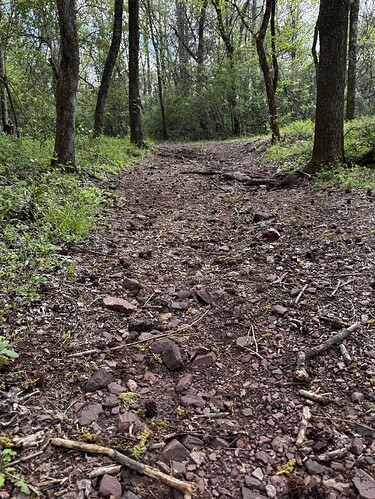Yes. Aero tested recently w 40 mm and 52 mm tires. They work
Yep, I’d run matched sizes for gravel if I could in most cases, just not as much room in the rear on my current bike. But there is a significant handling benefit also provides a little suspension up front. Besides cornering/descending benefits in loose conditions, a wider front tire can be a big advantage in deep sandy stuff (much less chance of that front wheel grabbing).
RE: Aero concerns vs rolling resistance. We should always remember that aero concerns do not really matter much when one is drafting in the bunch, but rolling resistance matters all the time. This factor alone means that rolling resistance is a bigger factor, especially considering racing speeds in gravel. I am not suggesting that aero does not matter at all, many times I have been chasing, alone, to a group ahead, and am thankful for being having trained to get in a reasonably good aero position, I am just pointing out that RR is more important.
Agreed in the limited context of tires, but aero overall still trumps rolling resistance by a healthy margin unless you are going really slow through mud or very chunky gravel. I’m pretty sure that’s what you meant, just calling it out for anyone who might think rolling resistance is a bigger factor compared to the overall aero factor. When moving at decent speeds (even in the draft), aero is still sucking most of the watts. And body position on the bike is still the biggest difference maker for aero.
Aero overall is the biggest factor for the full system yes.
Aero of the front tyre is a small part of that larger aero penalty.
front tyre as a system, the rolling resistance benefit of the larger tyre, outweighs the aero penalty of the slightly bigger tyre.
Generally agree (particularly when the road/gravel gets rougher and speeds get lower), but it obviously depends on how big the rolling resistance difference is vs. the amount of the aero penalty. Like most of this stuff, it’s highly dependent on course, speeds, and strengths/weaknesses of the tires being used. I recently tested a front race king vs. a front pathfinder pro and the pathfinder pro was a bit slower on a mixed surface course. Rolling resistance of pathfinder tests slower, but it was faster. I’d attribute that to being ~9mm narrower and more aero.
No misunderstanding, had just moved on to additional discussion. And totally agree that wider probably has more rolling resistance benefits in the rear without as much aero penalty. But many bikes have more limited clearance in the rear so people tend to run a staggered setup. I look at the front on it’s own and there are certainly cases where larger makes sense with lower rolling resistance and better handling trumping aero losses. Would there be cases where you run larger in the rear and smaller in the front? Maybe, but if a road is rough enough to favor a wider tire, it’s often going to favor it front and back and having a grippier tire in the rear (compared to front) can also cause some handling challenges (ie- crashes).
edit - I wouldn’t read too much into tire wear as an indicator of rolling resistance percentage. Sure, some of that wear is related to weight and corresponds to Crr, but mostly they were faster because the rear is the drive wheel. Drive wheels always wear faster whether they are carrying more or less of the load compared to non-drive wheels.
Haven’t read that one but I’d wager they then referred not to a crr distribution but a resistance/watts lost distribution. That would make sense as the resistance is crr times load on the respective tire. So in a typical road bike weight distribution on the flats it’s somewhat 40 %'ish of total weight on front and 60’ish on rear tire? Some tire pressure calculators even let you take this into account for their recommendations.
That would then give you the answer you were looking for. But it will change on rider position on the respective bike and whether on flats, up- or down hills.
Wasn’t planning this at all, but landed a spot for Cat 4 Gravel Chung Method testing today.
It’s pretty sketchy, so not putting it in the regular test course rotation but definitely interesting.
Excellent, very interesting. Did you manage to ride the course without braking? That must be tricky, as well as the challenge of repeating the same line.
Interesting stuff yet again.
The Thunder Burt jumped by 0.0066 CRR from cat 2 to cat 3, and by 0.0035 from 3 to 4. In comparison, both of the 2.4" tires only jumped by 0.0037 from 2 to 3. Assuming that ratio stays constant would lead to a CRR of 0.0175 for the Peyote and 0.0189 for the Aspen on cat 4, in comparison to the 0.0202 of the Thunder Burt.
That seems reasonable on such a chunky course.
UK grade 1. Nice
Correct no braking. Took a few tries to get length correct on it!
Nin that sounds quite reasonable to me.
Apparently Maxxis is coming out with something new in April 10th. The good news for them is that the expectations for a good rolling resistance is pretty low…
I know the picture is very fuzzy but these don’t look like huge MTB tires lol
Curious what they are!
My assumption is a new gravel tire in the 50mm range. A 50 rambler? If so, no one is going to care that isn’t paid to ride their tires.
If you need further proof that no one cares… The 50mm Rambler has been out for years… hahaha…
![]()
Maxxis heard that a MTB tire is the fastest and best tire for gravel racing so went all in with DHF/DHR for gravel! ![]()

